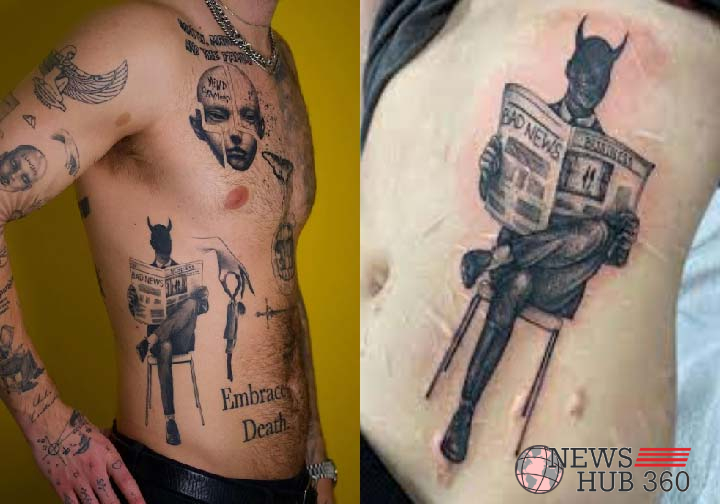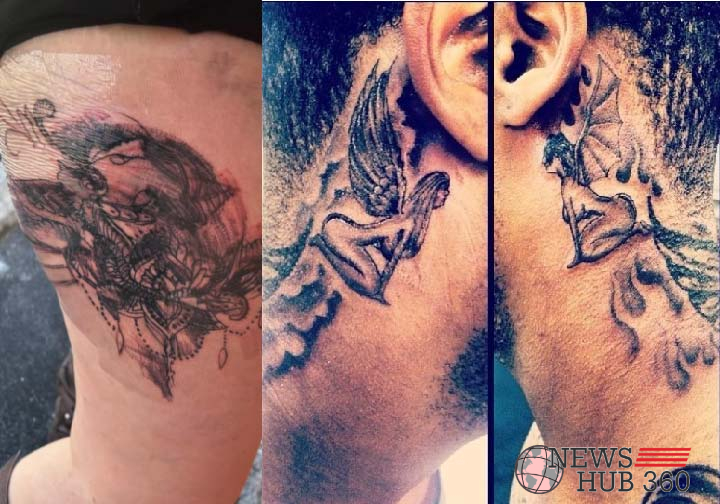Introduction
We’ve all seen them—bad tattoos that make you wonder, “What were they thinking?” Whether it’s a misspelled word, an ill-thought-out design, or a tattoo that didn’t age well, bad tattoos often become the subject of public ridicule and sometimes even the news. But how do these tattoo nightmares happen? More importantly, how can you avoid becoming the next headline in “bad tattoos news”?
In this article, we’ll dive into the world of bad tattoos news, exploring why they happen, how to fix them, and real-life stories that have made waves in the media. Along the way, you’ll learn tips for ensuring that your ink remains a masterpiece, not a mishap.
1. What Defines a “Bad Tattoo”?
A bad tattoo isn’t just about poor quality; it’s about regret. A bad tattoo can be a misspelling, a design that didn’t turn out as expected, or even something deeply personal that just doesn’t resonate anymore. Maybe the lines are shaky, or the colors have faded, or the concept itself was ill-advised.
Imagine getting a tattoo of your favorite band’s logo, only to find out they broke up the following week. Sometimes, even the best intentions lead to lifelong regret.
2. Common Causes of Tattoo Regret
Why do people regret their tattoos? Often, it’s because they made a quick, impulsive decision without thinking it through. For some, it’s about getting a tattoo that represents something temporary, like a fleeting relationship or a trend that’s bound to die out.
Another major cause of regret is choosing the wrong artist. Tattooing is an art form, and not all tattoo artists are created equal. Poor technique, lack of experience, or simply a mismatch in style can all lead to less-than-stellar results.
3. Famous Tattoo Fails That Made Headlines
Bad tattoos make for great news stories. Take, for instance, the notorious case of a man who wanted a tattoo of his girlfriend’s name but ended up with a misspelled version. Or the celebrity who got a tattoo in a foreign language, only to later find out it didn’t mean what they thought it did.
One famous headline involved an individual who got a huge, intricate tattoo of their favorite sports team’s mascot, only to have the team change their logo the following year. Ouch.
4. Why Do Bad Tattoos Go Viral?
The rise of social media means that bad tattoos can spread like wildfire. Platforms like Instagram and TikTok are filled with “tattoo fails” that get shared, commented on, and meme-ified. But why do these stories go viral?
It’s a combination of shock value and humor. People love a good cringe-worthy story, and bad tattoos news offer plenty of that. Add in the visual element, and it’s no wonder these stories capture attention. But behind the laughs are real people dealing with regret.
5. Tattoo Removal: Is It Really That Easy?
Many people believe that if they don’t like a tattoo, they can just have it removed. But the reality isn’t that simple. Laser tattoo removal can be painful, expensive, and time-consuming. It often takes multiple sessions to fully erase a tattoo, and some colors are more difficult to remove than others.
On top of that, there’s no guarantee that the tattoo will be completely erased. In some cases, remnants of the design may linger, leaving a shadowy reminder of the past mistake.
6. Cover-Ups: Turning a Mistake into a Masterpiece
For those who can’t face the thought of removal, there’s another option: a cover-up. A talented artist can transform a bad tattoo into something new, incorporating the old design into a fresh piece of art.
Cover-ups, however, come with their own challenges. The new design often needs to be bigger and bolder than the original, which may limit your options. Still, many people find this to be a satisfying way to turn their tattoo regret into something they can be proud of.
7. How to Avoid a Bad Tattoo in the First Place
The best way to avoid a bad tattoo is to take your time. Don’t rush into a decision. Research artists thoroughly, making sure they specialize in the style you want. Look at their portfolio and read reviews from previous clients.
Consult with your artist before committing. Discuss the design, placement, and size. If something doesn’t feel right, don’t be afraid to speak up or walk away. It’s better to be cautious than to regret your decision later.
8. Tattoo Trends: What’s Hot vs. What’s Not
Tattoo trends come and go. At one point, tribal tattoos were all the rage. Then came the rise of watercolor designs and minimalist line tattoos. While it’s tempting to jump on the latest trend, be mindful of the fact that what’s popular today may not be tomorrow.
Before getting a trendy tattoo, ask yourself: will I still love this design in 10 or 20 years? Classic designs tend to stand the test of time, while trendy ones may lose their appeal as fashions change.
9. Celebrity Tattoo Disasters
Celebrities are no strangers to bad tattoos. From misspelled words to designs they later regretted, even the rich and famous aren’t immune to tattoo fails. Some of the most notable examples include actor Ben Affleck’s massive back tattoo, which became a viral sensation, and Ariana Grande’s infamous palm tattoo that was supposed to say “7 Rings” in Japanese but ended up meaning “small charcoal grill.”
These celebrity tattoo disasters serve as cautionary tales—if it can happen to them, it can happen to anyone.
10. The Role of Social Media in Tattoo Shaming
Social media plays a huge role in amplifying tattoo fails. Bad tattoos can quickly become the subject of memes, reaction videos, and viral posts. This phenomenon has led to a new form of public shaming, where individuals’ tattoo mistakes are broadcast for the world to see.
While some may laugh it off, others find it incredibly hurtful. After all, tattoos are deeply personal, and being publicly mocked can add to the emotional toll of already regretting a tattoo.
11. Can a Bad Tattoo Ruin Your Reputation?
In some cases, a bad tattoo can have more serious consequences than just personal regret. Depending on the design, a tattoo could be seen as offensive or inappropriate, potentially harming your professional or personal reputation.
For example, some employers may frown upon visible tattoos, especially if the design is controversial. In extreme cases, individuals have lost job opportunities or faced social stigma due to their tattoos.
12. Legal and Health Issues with Bad Tattoos
Bad tattoos can lead to more than just emotional pain—they can also cause legal or health issues. If a tattoo is poorly done or not properly sanitized, it can lead to infections or even long-term health problems. In rare cases, individuals have filed lawsuits against tattoo artists for negligence.
Additionally, tattoos that infringe on copyright or feature offensive imagery can lead to legal challenges. It’s crucial to ensure that your tattoo is not only safe but also free from any potential legal complications.
13. How to Choose the Right Artist
Choosing the right artist is arguably the most important step in avoiding a bad tattoo. Start by researching local tattoo shops and artists. Look for reviews, testimonials, and portfolios of their previous work.
Meet with the artist in person to discuss your design ideas. A good tattoo artist will not only be skilled but also willing to collaborate with you to bring your vision to life. Don’t settle for an artist just because they’re cheap—quality matters more when it comes to something permanent.
14. Tattoo Aftercare: Preventing a Bad Outcome
Even a well-done tattoo can turn bad if it’s not properly cared for. Tattoo aftercare is crucial to ensuring that your new ink heals correctly and looks its best. Follow your artist’s aftercare instructions carefully, which may include keeping the area clean, avoiding sun exposure, and applying healing ointments.
Failing to care for your tattoo can lead to infections, fading, or scarring, all of which can contribute to tattoo regret.
15. Conclusion and Lessons Learned
Bad tattoos are more common than you might think, but they’re also preventable. By taking your time, choosing the right artist, and thinking carefully about your design, you can avoid becoming the next headline in bad tattoos news. If you do end up with a tattoo you regret, remember that options like removal or cover-ups exist. In the end, it’s all about learning from your mistakes and moving forward.
FAQs
1. Can I remove a tattoo completely?
Tattoo removal can be effective, but it often requires multiple sessions and may not erase the tattoo entirely.
2. How much does tattoo removal cost?
The cost varies depending on the size and color of the tattoo, but it can range from several hundred to thousands of dollars.
3. What should I do if I regret my tattoo?
You can consider options like removal or cover-ups. Consulting with a skilled tattoo artist or dermatologist is a good first step.
4. How long does it take for a tattoo to heal?
Typically, a tattoo takes 2-4 weeks to heal on the surface, but full healing can take a few months.
5. Can I sue a tattoo artist for a bad tattoo?
In some cases, you can pursue legal action if the artist was negligent or caused harm, but this can be a complex process.



